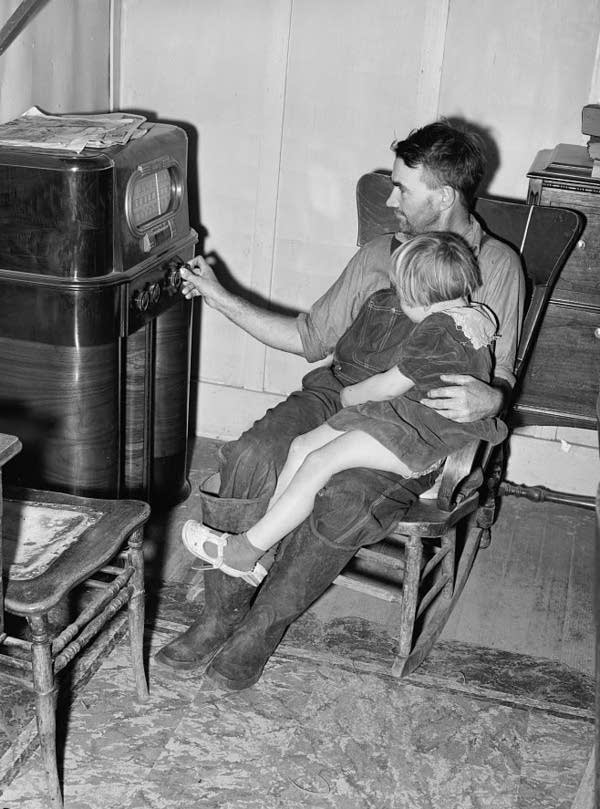Radio: The Internet of the 1930s
Some predicted radio would be a powerful force for democratizing information and spreading knowledge to a vast population previously separated by geography or income. But the new technology also raised anxieties.

Franklin and Eleanor Roosevelt adopted radio as a communication tool when the medium was so new no one was certain what place it would find in American culture. Radio was an unknown force, and it came right into people’s homes and spoke to them intimately. It seemed to have the potential for both good and evil.
The first commercially licensed radio station in the United States was KDKA in Pittsburgh. In 1920, it began broadcasting from the roof of the Westinghouse Electric factory, which owned the station and built radio receivers. Virtually no one owned a radio set, but on election night that year, KDKA broadcast news of Warren G. Harding’s victory in the presidential election, passing along returns phoned in from the local newspaper. The number of licensed broadcast stations surged from five in 1921 to 500 by 1924. Radio quickly became a consumer craze.
In 1930, more than 40 percent of American households owned a radio. A decade later that number more than doubled, to 83 percent. Live musical performance dominated the airwaves in the early years. Dramas, comedy acts, talk and educational programs soon followed. Local stations and national networks generally left news to the newspapers until the advent of World War II. In the early years, household radio ownership was highest in the Northeast and on the West Coast. In large sections of the South, Midwest and Great Plains, stations and radio sets were scarce. As the New Deal’s rural electrification program wired up remote communities and farmsteads, the number of households with a radio also grew. While the privations of the Great Depression forced some poor households to do without radio, others bought radio sets because, with one purchase, they brought home a constant, free stream of entertainment.

The early public discussion of radio’s influence on society and culture reads much like the debates about the initial promises and dangers seen in the 21st century Internet revolution. Some predicted radio would be a powerful force for democratizing information and spreading knowledge to a vast population previously separated by geography or income. But the new technology also raised anxieties. Observers worried about the propriety and taste of the radio programs that would penetrate the sanctity of the home. Some critics of the radio fad worried that if families stayed home with the wireless it would erode civic involvement and compete with traditional social gatherings. In 1932, journalist Anne O’Hare McCormick wrote a series of reports for the New York Times analyzing radio as a “great unknown force.” She observed that radio listening was a passive, vicarious experience with a “dazing, almost anesthetic effect upon the mind.”

But McCormick also saw a new mass audience forming that was “[m]ore inclusive, more rural, more domestic, whatever you think of its taste more broadly American.” Radio was the first truly mass medium, linking great cities and remote hamlets in the same instantaneous event. Some social commentators believed radio would unleash new democratic energies, creating a “national town meeting” on the air. A number of programs used the town meeting motif explicitly. Some observers believed radio would draw Americans together as never before, creating the kind of informed, ideal republic imagined by the nation’s founding generation. Doubters of radio, as scholar Jason Loviglio writes, feared “hypnotized audiences falling under the sway of irrational forces like fascism, communism, or even a corrupt and bankrupt capitalism.”
High-minded anxieties did little to thwart the public’s embrace of broadcasting. In 1932, the year FDR was first elected president, the two primary broadcasting companies, NBC and CBS, were well established. Surveys found that listeners in the 1930s spent an average of more than four hours a day listening to radio broadcasts. Early adopters of the new technology included populist politicians Huey Long in Louisiana and Floyd B. Olson in Minnesota, who attracted followers through radio broadcasts of their speeches. So did the incendiary radio priest Charles Coughlin. And aviator Charles Lindbergh used radio to exhort isolationist forces opposed to American involvement in World War II.
In the 1940s, radio’s cultural and political influence continued to surge. Once the United States declared war against Japan and Germany, the national networks willingly joined the crusade, producing patriotic dramas and variety shows and giving over valuable air time to programs produced by federal agencies. The networks also built up news departments to cover national and international affairs, and mounted unprecedented wall-to-wall coverage of D-Day on June 6, 1944.

After the war, television displaced radio as the America’s electronic hearth. And the most dramatic expectations of radio’s social impact never fully materialized. Radio did not produce a nation of anesthetized drones. Nor did it create a startling new age of engaged citizenship. Some historians argue that radio played a role in helping create a new sense of national belonging in what had previously been a patchwork of regional identities.
Social scientists in the 1940s and onward debated how significant radio’s impact was on the decision-making process of the American voter. Some argued that radio was powerfully influential. Others contended that radio broadcasts on behalf of a candidate or party merely reinforced preconceived opinions. In the 1950s, radio was eclipsed by television as a political forum. But in the years following FDR’s presidency, no candidate for the White House could win without campaigning on the air.

